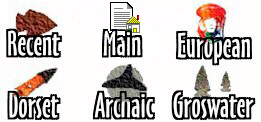![[Header]](masterhead.jpg)
![[Header]](masterhead.jpg)
Groswater Paleoeskimos are known by their beautifully made tools. Archaeologists have had the chance to study a great many of them during the excavation of their seal hunting camps near Phillip's Garden. The tools tell us much about these nomadic hunters from the Arctic who migrated to this area and occupied it for over 900 years.
Raw Materials
Like all early peoples, the Groswater Paleoeskimos made their tools from a combination of materials, but it was rock that gave them an edge. Stone, the hardest substance in their world, was the raw material for knives, harpoon heads and cooking implements. The Port au Choix area provided a variety of stones to meet different manufacturing needs.
Cow Head Chert is a fine-grained, almost glassy material which breaks into thin flakes that can be shaped into very sharp tools. A good supply of this multi-colored stone is available south of Port au Choix at Cow Head.
Ramah Chert is found only at Ramah Bay in northern Labrador. Maritime Archaic artifacts made from this unique stone have been found as far south as Maine.
Soapstone, a form of talc, is soft and can be carved into cooking pots, lamps and figures. It also has a gritty surface that can be used to grind other tools. The Dorset Paleoeskimos quarried soapstone at Fleur de Lys, on the Baie Verte Peninsula.
Slate, a hard stone that can be sharpened by grinding and polishing, is found in several locations on the Great Northern Peninsula.
Quartz Crystals, found near Port au Choix, were often included in Maritime Archaic graves. Paleoeskimos manufactured them into tools.
![]()
Follow These Links
Masters of Craft
![]()
